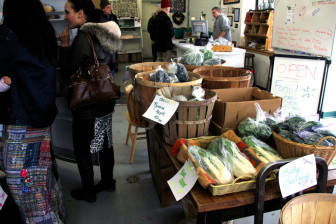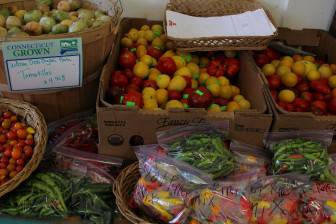Kylee Mowel gladly makes the 15-mile trip from Middletown to New Britain each week to pick up locally grown organic produce from Urban Oaks Organic Farm.
The farm’s store offers fresh greens year round, plus a variety of seasonal produce, meat, eggs, bakery and specialty foods produced in the region.

Kathleen Schassler Photos
Shoppers at Urban Oaks in New Britain.
By buying local and choosing organic, Mowel, 27, said she can avoid Genetically Modified Organisms (GMO) in her food. Her choice reflects a growing cultural shift toward healthier eating habits that support sustainable agriculture.
“Ten years ago we had a hard time selling greens. Now it flies off the shelves,” said organic farmer Mike Kandefer of Urban Oaks.
The shift in consumer awareness on food issues gained momentum last year when Gov. Dannel P. Malloy signed the nation’s first law requiring Genetically Modified Organisms (GMO) in food to be labeled.
“For a few weeks after (the GMO legislation) was in the news, I had a bunch of calls asking about GMOs in our products,” said Deb Mardsen, owner of Connecticut Farm Fresh Express, which links consumers with up to 50 local farms.
Even before the legislation passed, the acreage devoted to organic pasture and cropland in Connecticut in one year – rose from 33,401 acres in 2010 to 69,549 in 2011, according to the U.S. Department of Agriculture. In all, there are about 6,000 farms operating in the state – an increase from 4,900 five years ago, according to the department.
“We’ve seen a steady increase in people who want to farm organic,” said Bill Duesing, a longtime organic advocate with CT NOFA, the Connecticut chapter of the Northeast Farming Association. “It’s really phenomenal.”
The largest certifier of organic farms in Connecticut, Baystate Organic Certifiers, has certified 52 farms in the state, executive director Don Franczyk said. That’s up from about 30 farms in 2002.
Duesing said that the official organic statistics don’t even include growers who take a non-binding Farmer’s Pledge to use organic methods, or people like himself who grow less than $5,000 worth of organic products a year.
Duesing, who grows organic fruits, vegetables and garlic with his wife, Suzanne, in Oxford, said the food tastes better, is more nutritious and is better for the planet.
“We all have to get to good health,’’ he said. “To do that, we have to start with food.”
As a first-time owner of a full share in the Community Supported Agriculture program —also called a Buyer’s Club—Mowel relies upon a weekly order of fresh food to split with her mother. The cost: $600 for 12 weeks of food, plus members get a 10 percent discount on any additional purchases in the market.
“The drive is worth it,” Mowel said. “We should know what we’re eating.”
The U.S. Food and Drug Administration says consumers should not be worried about genetically modified foods, which were introduced into the American food supply in the mid-1990s. But many consumer groups believe that GMO foods are dangerous and should not be freely available in the food supply.
 Since the Connecticut GMO bill requires at least four other Northeastern states with a combined population of no fewer than 20 million to approve similar acts before it can officially go into effect, avoiding GMOs is likely to remain difficult for consumers for now.
Since the Connecticut GMO bill requires at least four other Northeastern states with a combined population of no fewer than 20 million to approve similar acts before it can officially go into effect, avoiding GMOs is likely to remain difficult for consumers for now.
A GMO is the result of a laboratory process in which genes from the DNA of one species are extracted and artificially forced into the genes of an unrelated plant or animal. GMOs are present in the majority of processed foods in the U.S. The products created include oils, soy protein, soy lecithin, corn starch, corn syrup and high fructose corn syrup.
Health conscious consumers who “eat clean” by consuming a whole food diet of fruits, vegetables and grains, while avoiding processed foods, are naturally steered away from GMO foods, said Pauline Weissman, a board-certified nutrition specialist from West Hartford.
Clean foods are free of artificial preservatives, coloring, irradiation, synthetic pesticides, fungicides, ripening agents, fumigants, drug residues and growth hormones. They typically don’t include foods that are processed, packaged, transported and stored.
“People need to know what ingredients are in the food they eat,” said Alison Anderson, a consumer at a Hartford Farmer’s Market. “If the FDA and agrichem giants refuse to tell me, I’ll just avoid them on my own.”
Kathleen Schassler is a journalist and a graduate student at Quinnipiac University. You can reach her at @ImKat17 on Twitter.